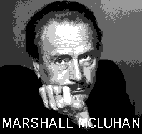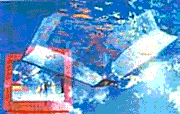2.1. Marshall McLuhan: Mediatheory as Form-Analysis
The cultural analyses of Marshall McLuhan were to the 1960s what Baudrillard, Kroker and Cook, and Deleuze and Guattari are to the postcyberpunk era. - Larry McCaffrey
 The brightest personality in mediatheory as form-analysis is the
canadian mediatheorist Marshall McLuhan. He created something
like a new paradigm of mediatheory and so overcame already a pure
hardware view. His theory of cultural development, comprehend
the history of the west as a history of media. Therefore mankind
evolves from the 'preliterate man' to the 'educated man' to the
'electronic man'.
The brightest personality in mediatheory as form-analysis is the
canadian mediatheorist Marshall McLuhan. He created something
like a new paradigm of mediatheory and so overcame already a pure
hardware view. His theory of cultural development, comprehend
the history of the west as a history of media. Therefore mankind
evolves from the 'preliterate man' to the 'educated man' to the
'electronic man'.
 As 'preliterate man', mankind lived without the knowledge of script,
totally connected to his only acoustic environment, in a mystical
and undivided world. All he did was translating his whole body
into outer forms like a ship a house or a social role. In the
second phase of mankind, the 'educated man' created contact with
its environment by transferring bodily functions in form of tools
into his environment and therefore created a distance between
himself and his environment. He also visualised the acoustic space
with written and printed language. For Marshall McLuhan a book
is nothing else than an extension of the eye and all books together
form the Gutenberg-galaxy. In creating a book, mankind also invented
something like the linear logic, which found expression in a linear
book. More and more tools brought man more and more in distance
to his environment. The third step in this theory of development
is today's electric/electronic man as 'manthefactfinder'. This
type of human being is similar to the 'preliterate man', bringing
himself in contact to the world through alienation and amputation.
The information-network is his nervous system. He lives in an
acoustic space again, where he becomes bombarded with signals.
He does not have to string together fragments to make sense. He
does not have to think linear or coherent anymore.
As 'preliterate man', mankind lived without the knowledge of script,
totally connected to his only acoustic environment, in a mystical
and undivided world. All he did was translating his whole body
into outer forms like a ship a house or a social role. In the
second phase of mankind, the 'educated man' created contact with
its environment by transferring bodily functions in form of tools
into his environment and therefore created a distance between
himself and his environment. He also visualised the acoustic space
with written and printed language. For Marshall McLuhan a book
is nothing else than an extension of the eye and all books together
form the Gutenberg-galaxy. In creating a book, mankind also invented
something like the linear logic, which found expression in a linear
book. More and more tools brought man more and more in distance
to his environment. The third step in this theory of development
is today's electric/electronic man as 'manthefactfinder'. This
type of human being is similar to the 'preliterate man', bringing
himself in contact to the world through alienation and amputation.
The information-network is his nervous system. He lives in an
acoustic space again, where he becomes bombarded with signals.
He does not have to string together fragments to make sense. He
does not have to think linear or coherent anymore.
Out of this little summary of McLuhan's article Culture without literacy (1953) one can already see some of his basic ideas. Here he laid down the basics for many of his later utterances which can often so easily be reduced to simple sentences, like the first law of communication: "The medium is the message" (McLuhan 1967) which means the hardware of the medium determines its limits and the contents of media is nothing else than other media. Following this logic there can be nothing except of media by definition. In fact for him everything is a medium and "all media are extensions of certain human talents - either psychical or physical. The wheel is an extension of the foot - the book an extension of the eye - the clothes an extension of the skin, the electronic circuit an extension of the central nervous system. (McLuhan 1969: 26ff. -transl. by S.J.) Eyerything is a medium, because every object transmits meaning and therefore widens our worldview. Every object extends our senses.
The content of a medium is not of primarily interest as a content, as it is a medium itself: 'nothing ever printed is as important as the medium of print.'(quoted by Agentur Bilwet 1993: 232 -transl. S.J.) So for McLuhan the difference between hardware and content dissolves.
Interesting also is that for him education belongs to the time of the Gutenberg-galaxy, but the 'electronic man' is already beyond. It does not make any sense anymore to think linear, logical or coherent. It can even be dangerous.
What McLuhan did was in fact not so much creating a deep theory but more or less creating a certain method of knowledge which he called: 'pattern recognition'. "For him historical data is nothing more than material to recognize patterns but it offers no solution for questions like: What should be done? In the network of the media we find ourselves beyond linearity and that is why we should understand how they work. The only possibility to take power away from media is to understand their laws." (Agentur Bilwet 1993: 237 -transl. S.J.)This method blew the boundaries of a linear time. McLuhan said: "I predict only what has already happened. Anyone who truly perceives the present can also see the future, since all possible futures are contained in the present."(quoted by Agentur Bilwet 1993: 236 -transl. S.J.).
What McLuhan did in the end was creating mediatheory as theory about everything, because there is nothing except of media. There is no longer a single item which is not interesting for mediatheory. And therefore mediatheory is nothing more or less than the glasses you put on to enjoy the universal data-archive without following the idea to get something like an overview ever. Mediatheory for McLuhan is also the theory about reality or what is left of reality. It inherits the role of philosophy. In terms of mediatheory rationalism, empiricism, positivism, existentialism etc. were the glasses to wear to view reality in the age of the educated man.
 According to McLuhan we are now entering or have already entered
another stage in our development, we leave the age of the educated
man and leave literacy behind us to reach the level of the electronic
man. Therefore also our reality is subject to changes and the
theory that we use to describe reality, respectively the glasses
we wear to perceive reality.
According to McLuhan we are now entering or have already entered
another stage in our development, we leave the age of the educated
man and leave literacy behind us to reach the level of the electronic
man. Therefore also our reality is subject to changes and the
theory that we use to describe reality, respectively the glasses
we wear to perceive reality.
A new question, mediatheory is concerned with is what happens if we have not only an extended body, but also an extended mind, like McLuhan states or predicts: "During the mechanical ages we had extended our bodies in space. Today, after more than a century of electric technology, we have extended our central nervous system itself in a global embrace, abolishing both space and time as far as our planet is concerned. Rapidly we approach the final phase of the extensions of man - the technological simulation of consciousness, when the creative process of knowing will be collectively and corporately extended to the whole of human society, much as we have already extended our senses and our nerves by the various media."(McLuhan 1967: 11)
![]()